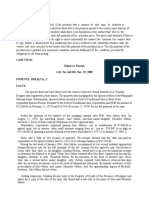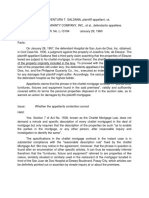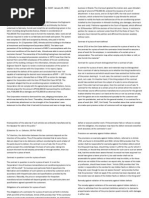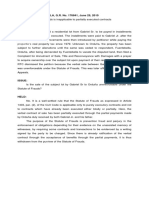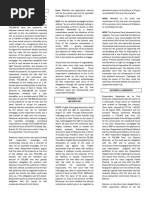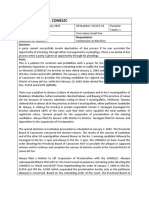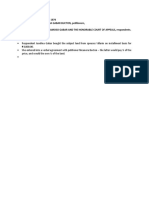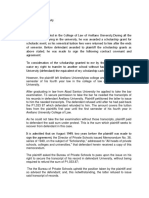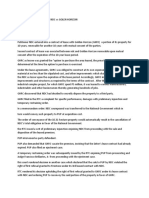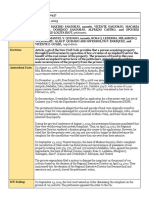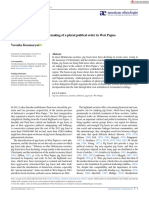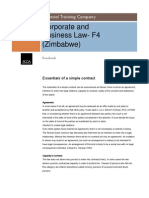Heirs of Maximo Sanjorjo V
Heirs of Maximo Sanjorjo V
Uploaded by
ohmygodsunCopyright:
Available Formats
Heirs of Maximo Sanjorjo V
Heirs of Maximo Sanjorjo V
Uploaded by
ohmygodsunCopyright
Available Formats
Share this document
Did you find this document useful?
Is this content inappropriate?
Copyright:
Available Formats
Heirs of Maximo Sanjorjo V
Heirs of Maximo Sanjorjo V
Uploaded by
ohmygodsunCopyright:
Available Formats
Retzelyn Mae G.
Quintana
Heirs of Maximo Sanjorjo v. Heirs of Manuel Quijano (449 SCRA 15) Facts: On August 29, 1988, Free Patent No. VII-4-2974 was issued to Alan P. Quijano over a parcel of land identified as Lot 374, Cadastre 374-D wherein Original Certificate of Title (OCT) No. OP-38221 was issued in his name. Meanwhile, on November 11, 1988, Free Patent No. VII-4-3088 was issued in favor of Gwendolyn Q. Enriquez for Lot 379, Cadastre 374-D in which OCT No. OP-39847 was also issued in her name. Alan Quijano and Gwendolyn Enriquez are among the heirs of Manuel Quijnao who are the private respondents in this case. Enriquez filed an application for a free patent over Lot 376 of Cadastre 374-D with the Department of Environment and Natural Resources (DENR). She also filed an application for a free patent over Lot 378. However, the heirs of Guillermo Sanjorjo, filed a protest/complaint with the DENR praying for the cancellation of Free Patent Nos. VII-4-2974 and VII-4-3088, and for the dismissal of the free patent applications over Lots 376 and 378. The protestants/claimants alleged that the said parcels of land were originally owned by Ananias Ursal but were exchanged for a parcel of land, owned by their predecessor, Guillermo Sanjorjo, and from whom they inherited the property. However, the protestants/claimants withdrew their protest/complaint. Thus, on April 14, 1992, the Regional Executive Director rendered a decision giving due course to the applications. However, he ruled that the free patents over Lots 374 and 379 could no longer be disturbed since the complaint for the cancellation was filed more than one year from their issuance. On September 13, 1993, petitioners Vicente Sanjorjo, the heirs of Maximo Sanjorjo, and Spouses Inot, filed a complaint for cancellation of titles under tax declarations and reconveyance of possession of real property covering the Lots 374, 376, 378 and 379, against the private respondents, the heirs of Manuel Quijano and Vicente Gulbe. Petitioners allege that they are the owners of several parcels of land covering Lots 374, 376, 378 and 379 which they inherited from their grandfather the late Maximo Sanjorjo. According to the petitioners, sometime in 1983, the parcels of land in question were leased to Manuel Quijano for a two (2) year period. However, the lease was never paid for nor was possession of the said properties ever returned to the petitioners, despite repeated demands on Quijano to return the same. When Manuel Quijano died, his heirs divided among themselves the land belonging to the petitioners. Plaintiffs averred that they nor their ascendants have never sold, donated, or mortgaged any of these lots in question to the defendants or their ascendants. On the other hand, private respondents filed a motion to dismiss the complaint on the ground of res judicata based on the decision of the Regional Executive Director on April 14, 1992. They maintained that the decision of the Regional Executive Director had become final and executory and, as such, barred the petitioners action. They also invoked that the petitioners action was barred by the issuance of OCT No. OP-38221 covering Lot 374, and OCT No. OP-39847 covering Lot 379. The Regional Trial Court dismissed the complaint on the ground of res judicata. On appeal, petitioners limited the issue to Lots 374 and 379 only. The appellate court affirmed the order of the trial court although for a different reason, i.e., prescription.
Issue: WON petitioners action for the reconveyance of Lots 374 and 379, covered by OCT No. OP-38221 and OCT No. OP-39847 respectively is barred by prescription.
Held: No, the action for reconveyance of the lots in question has not yet prescribed. A Torrens title issued on the basis of the free patents became as indefeasible as one which was judicially secured upon the expiration of one year from date of issuance of the patent. However, an aggrieved party may still file an action for reconveyance based on implied or constructive trust, which prescribes in ten years from the date of the issuance of the Certificate of Title over the property provided that the property has not been acquired by an innocent purchaser for value. The presence of fraud or mistake creates an implied trust for the benefit of the rightful and legal owner giving him the right to seek reconveyance of the property. All that must be alleged in the complaint are two acts: (1) that the plaintiff was the owner of the land and, (2) that the defendant had illegally dispossessed him of the same. In their complaint, the petitioners clearly asserted that their predecessors-in-interest have long been the absolute and exclusive owners of the lots in question and that they were fraudulently deprived of ownership thereof when the private respondents obtained free patents and certificates of title in their names. Article 1456 of the New Civil Code provides that a person acquiring property through fraud becomes by operation of law a trustee of an implied trust for the benefit of the real owner of the property. The presence of fraud in this case created an implied trust in favor of the petitioners, giving them the right to seek reconveyance of the property from the private respondents. However, because of the trial courts dismissal order, the petitioners have been unable to prove their charges of fraud and misrepresentation. The petitioners action for reconveyance may not be said to have prescribed, for, basing the present action on implied trust, the prescriptive period is ten years. The questioned titles were obtained on August 29, 1988 and November 11, 1988, in OCT Nos. OP-38221 and OP-39847, respectively. The petitioners commenced their action for reconveyance on September 13, 1993. Since the petitioners cause of action is based on fraud, deemed to have taken place when the certificates of title were issued, the complaint filed on September 13, 1993 is, therefore, well within the prescriptive period.
You might also like
- Astm e 2930 - 13Document8 pagesAstm e 2930 - 13Martin Chimenti - ARO SA100% (1)
- Computer Masti Level 6Document138 pagesComputer Masti Level 6Rupesh Kumar Shah75% (4)
- Decision AnalysisDocument37 pagesDecision AnalysisMay Ann Agcang SabelloNo ratings yet
- Heirs of Sanjorjo v. Quijano - G.R. No. 140457, 19 January 2005Document4 pagesHeirs of Sanjorjo v. Quijano - G.R. No. 140457, 19 January 2005alilramonesNo ratings yet
- Atok Big Wedge Mining Co Vs HON IAC Et Al - G.R. No. 63528 September 9, 1996Document17 pagesAtok Big Wedge Mining Co Vs HON IAC Et Al - G.R. No. 63528 September 9, 1996Jacinto Jr JameroNo ratings yet
- Nabus vs. PacsonDocument6 pagesNabus vs. PacsonVaneza LopezNo ratings yet
- Navara Vs Planters DigestDocument2 pagesNavara Vs Planters DigestRonnieEnggingNo ratings yet
- Parties 1. Galido V Magrare 778 SCA 677Document2 pagesParties 1. Galido V Magrare 778 SCA 677Cesar CoNo ratings yet
- Paez Vs MagnoDocument1 pagePaez Vs MagnoZaira Gem GonzalesNo ratings yet
- DOCTRINE: The Fideicommissary Substitution Requires Three ThingsDocument3 pagesDOCTRINE: The Fideicommissary Substitution Requires Three ThingsRoland MarananNo ratings yet
- Panganiban, J.:: (G.R. No. 148267. August 8, 2002)Document6 pagesPanganiban, J.:: (G.R. No. 148267. August 8, 2002)Mary Denzyll BunalNo ratings yet
- 16 Acabal V AcabalDocument2 pages16 Acabal V AcabalpdasilvaNo ratings yet
- Adelfa v. CADocument2 pagesAdelfa v. CADennis CastroNo ratings yet
- Saldana vs. Phil. GuarantyDocument1 pageSaldana vs. Phil. GuarantyKeilah ArguellesNo ratings yet
- Uy Tina Vs AvilaDocument1 pageUy Tina Vs AvilaMargie Marj GalbanNo ratings yet
- AbayaDocument2 pagesAbayaReyshanne Joy B MarquezNo ratings yet
- Sales DigestDocument2 pagesSales DigestCess Bustamante AdrianoNo ratings yet
- 172 Ortega V LeonardoDocument2 pages172 Ortega V LeonardoMyk BercNo ratings yet
- Third Division (G.R. No. 226088, February 27, 2019)Document12 pagesThird Division (G.R. No. 226088, February 27, 2019)MosesNo ratings yet
- Carabeo Vs Dingco DigestDocument2 pagesCarabeo Vs Dingco DigestChester Pryze Ibardolaza TabuenaNo ratings yet
- Alfredo v. BorrasDocument19 pagesAlfredo v. BorrasYhelene Marie Avenido-AbiasNo ratings yet
- 10-Jovan Land Vs CA - Full CaseDocument5 pages10-Jovan Land Vs CA - Full CasepreiquencyNo ratings yet
- Andaya vs. ManasalaDocument2 pagesAndaya vs. ManasalaVilpa VillabasNo ratings yet
- General ProvisionsDocument47 pagesGeneral ProvisionsTricia SibalNo ratings yet
- Rule in Case of EvictionDocument1 pageRule in Case of EvictionMary CatchillarNo ratings yet
- Ormoc Sugarcane Planters' Association, Inc. vs. Court of Appeals, 596 SCRA 630Document6 pagesOrmoc Sugarcane Planters' Association, Inc. vs. Court of Appeals, 596 SCRA 630DNAANo ratings yet
- Digest - Ladanga vs. CADocument2 pagesDigest - Ladanga vs. CAsubarashi888No ratings yet
- Federico Serra V. The Hon. Court of Appeals and Rizal Commercial Banking Corporation G.R. No. 103338 January 4, 1994 FactsDocument4 pagesFederico Serra V. The Hon. Court of Appeals and Rizal Commercial Banking Corporation G.R. No. 103338 January 4, 1994 FactsJanine CastroNo ratings yet
- Engineering and Machinery Corp v. CADocument3 pagesEngineering and Machinery Corp v. CAyoahn_13No ratings yet
- Cebu Winland Vs Ong Sia HuaDocument1 pageCebu Winland Vs Ong Sia HuahappypammynessNo ratings yet
- SMC Employees Union v. ConfesorDocument1 pageSMC Employees Union v. ConfesorSha SantosNo ratings yet
- Uy and Sons Vs ValbuecoDocument9 pagesUy and Sons Vs ValbuecoKenmar NoganNo ratings yet
- MacapagalDocument13 pagesMacapagalcyhaaangelaaaNo ratings yet
- 07 Northern Motors V SapinosoDocument2 pages07 Northern Motors V SapinosoAgus DiazNo ratings yet
- ORDUA V FuentabellaDocument1 pageORDUA V Fuentabellaanon_71222979No ratings yet
- Oblicon 49 Unlad Resources Development Corp VS DragonDocument8 pagesOblicon 49 Unlad Resources Development Corp VS DragonAliceNo ratings yet
- Luis Pichel VS AlonzoDocument4 pagesLuis Pichel VS AlonzophgmbNo ratings yet
- Citibank N.A. v. SabenianoDocument3 pagesCitibank N.A. v. SabenianoDenise Carino100% (1)
- LAGAZO V. CA (Tito R. Lagazo, Petitioner, vs. Court of Appeals and Alfredo Cabanlit FactsDocument2 pagesLAGAZO V. CA (Tito R. Lagazo, Petitioner, vs. Court of Appeals and Alfredo Cabanlit FactsCZARINA ANN CASTRONo ratings yet
- Sales DigestDocument5 pagesSales DigestSheeray Cyclyd100% (1)
- Sta. Ana V Hernandez - G.R. No. L-16394Document2 pagesSta. Ana V Hernandez - G.R. No. L-16394Krisha Marie Tan BuelaNo ratings yet
- Chua vs. CaDocument3 pagesChua vs. CaANTHONY SALVADICONo ratings yet
- Binalay Vs Manalo DigestDocument1 pageBinalay Vs Manalo DigestMilcah MagpantayNo ratings yet
- 3.) 97 Alauya v. ComelecDocument2 pages3.) 97 Alauya v. ComelecVener Angelo MargalloNo ratings yet
- San Miguel Properties Phils., Inc. V Spouses Alfredo and Grace Huang, G. R. No. 137290, 31 July 2000Document2 pagesSan Miguel Properties Phils., Inc. V Spouses Alfredo and Grace Huang, G. R. No. 137290, 31 July 2000JOSHUA KENNETH LAZARONo ratings yet
- Eminent Domain DigestDocument19 pagesEminent Domain DigestNicole IbayNo ratings yet
- Bucton v. Gabar (G.R. No. L-36359, January 31, 1974)Document1 pageBucton v. Gabar (G.R. No. L-36359, January 31, 1974)Lorie Jean UdarbeNo ratings yet
- Dizon v. Dizon: Petitioners: Respondents: DoctrineDocument2 pagesDizon v. Dizon: Petitioners: Respondents: DoctrineShaneena KumarNo ratings yet
- D. Heunghwa Industry Co. Ltd. Vs DJ Builders Corp., 573 SCRA 240Document2 pagesD. Heunghwa Industry Co. Ltd. Vs DJ Builders Corp., 573 SCRA 240Valora France Miral AranasNo ratings yet
- Sabidong CaseDocument15 pagesSabidong Casejodelle11No ratings yet
- Case Digests Behn Meyer Vs YangcoDocument3 pagesCase Digests Behn Meyer Vs YangcoLouise Nicole AlcobaNo ratings yet
- Midterm Case DigestDocument4 pagesMidterm Case DigestAnny YanongNo ratings yet
- 135379-1983-Ridad v. Filipinas Investment and FinanceDocument6 pages135379-1983-Ridad v. Filipinas Investment and FinanceKrizel BianoNo ratings yet
- Case No. 9 Mendoza Vs Kalaw SALESDocument1 pageCase No. 9 Mendoza Vs Kalaw SALESCharlie BartolomeNo ratings yet
- Tec Bi & Co V Chartered Bank of India, Australia and ChinaDocument1 pageTec Bi & Co V Chartered Bank of India, Australia and ChinaJillian AsdalaNo ratings yet
- Sales 101Document8 pagesSales 101Ma. Goretti Jica GulaNo ratings yet
- 5 Cui Vs Arellano UniversityDocument3 pages5 Cui Vs Arellano UniversityGabriel DominguezNo ratings yet
- San Lorenzo Development Corporation vs. Court of AppealsDocument13 pagesSan Lorenzo Development Corporation vs. Court of AppealsElaine Belle OgayonNo ratings yet
- PUP vs. GHRCDocument3 pagesPUP vs. GHRCryan kiboshNo ratings yet
- CivPro Digests IIDocument5 pagesCivPro Digests IIAya BeltranNo ratings yet
- Sanjorjo vs. Quijano DigestDocument2 pagesSanjorjo vs. Quijano DigestXyrus BucaoNo ratings yet
- Heirs of Maximo Sanjorjo v. Heirs of Manuel Y. Quijano, 449 SCRA 15 (2005)Document3 pagesHeirs of Maximo Sanjorjo v. Heirs of Manuel Y. Quijano, 449 SCRA 15 (2005)Carie LawyerrNo ratings yet
- Heirs of Maximo Sanjorjo v. Heirs of Manuel Quijano GR No. 179540 March 13, 2009 FactsDocument2 pagesHeirs of Maximo Sanjorjo v. Heirs of Manuel Quijano GR No. 179540 March 13, 2009 FactsJanice Guen BeydenNo ratings yet
- Dcpa PlanningDocument17 pagesDcpa PlanningEdwardus AntoniusNo ratings yet
- Oracle HRMS Question e BookDocument37 pagesOracle HRMS Question e BookSyed Farhan Ashraf100% (1)
- Laporan Kejanggalan IR FY 2023Document20 pagesLaporan Kejanggalan IR FY 2023MP OM NorthNo ratings yet
- Warren Buffett - An InvestographyDocument178 pagesWarren Buffett - An InvestographyRajesh AgarwalNo ratings yet
- Biostat Lecture 5-1Document137 pagesBiostat Lecture 5-1ODAA TUBENo ratings yet
- 25 Minutes To GoDocument6 pages25 Minutes To Govilash7134No ratings yet
- Ilc Intro Pdftex03 03Document59 pagesIlc Intro Pdftex03 03KARKAR NORANo ratings yet
- HESIDocument6 pagesHESIBrian100% (1)
- Christian HumanismDocument3 pagesChristian HumanismNavisha BaidNo ratings yet
- A Detailed History of Goddess Hecate by Aaron WalkerDocument9 pagesA Detailed History of Goddess Hecate by Aaron WalkerMwelwa MwanzaNo ratings yet
- Sample Essay - 2Document1 pageSample Essay - 2aidil afiqNo ratings yet
- CriminiologyDocument24 pagesCriminiologyAbdullah AminNo ratings yet
- Acsm Committees DescriptionsDocument5 pagesAcsm Committees DescriptionsCinthiaDReisNo ratings yet
- SLA DefinitionsDocument2 pagesSLA DefinitionsLizzyNo ratings yet
- Working With DatabaseDocument105 pagesWorking With DatabaseTara Marie Robinson WhiteNo ratings yet
- Kusumaryati 2024 Pig Feast DemocracyDocument14 pagesKusumaryati 2024 Pig Feast DemocracyJirak sasakNo ratings yet
- 02 Formation of A ContractDocument14 pages02 Formation of A ContractMacjim Frank75% (4)
- CV Kariyono - 05 May 2017Document5 pagesCV Kariyono - 05 May 2017KariyonoNo ratings yet
- SynopsisDocument8 pagesSynopsisAlok SinghNo ratings yet
- CHOOSING NAIA PaperDocument6 pagesCHOOSING NAIA PaperElyssa DaggettNo ratings yet
- Ali Wyne - America's Great-Power Opportunity - Revitalizing U.S. Foreign Policy To Meet The Challenges of Strategic Competition-Polity (2022)Document251 pagesAli Wyne - America's Great-Power Opportunity - Revitalizing U.S. Foreign Policy To Meet The Challenges of Strategic Competition-Polity (2022)林維安No ratings yet
- Resume Sample FresherDocument1 pageResume Sample FresherLaxman Kanth NuthigattuNo ratings yet
- Release Notes SAP2000 v20.1.0Document8 pagesRelease Notes SAP2000 v20.1.0Nazim KASSABNo ratings yet
- Nursing Concept Map 1Document3 pagesNursing Concept Map 1Norah Okafor Ezike67% (3)
- Saludamay Nursing JournalDocument76 pagesSaludamay Nursing JournalcrisjavaNo ratings yet
- Sabid MC Neill Activity 3. Rizal's QuadrantDocument1 pageSabid MC Neill Activity 3. Rizal's QuadrantMC NEILL SABIDNo ratings yet
- Rubric EnglishDocument1 pageRubric EnglishLee Sy Lem100% (1)





